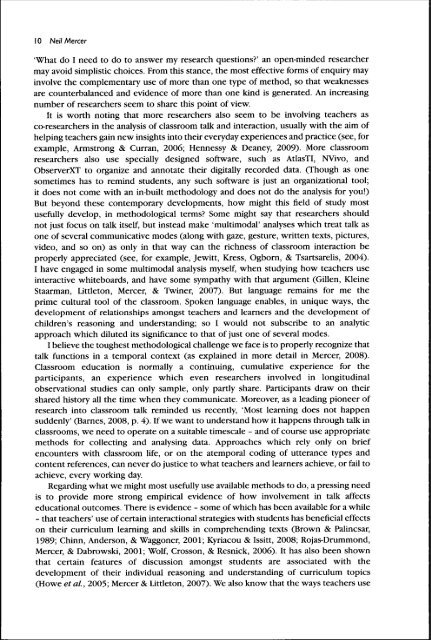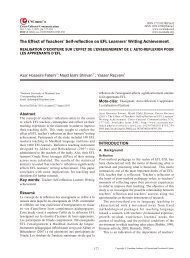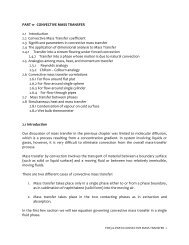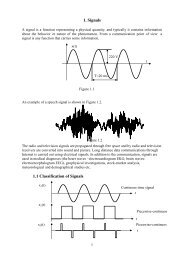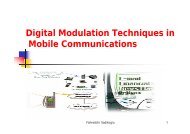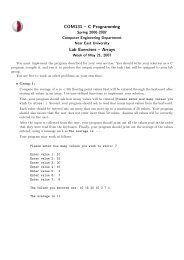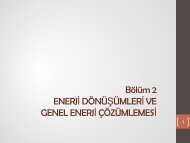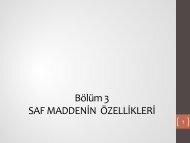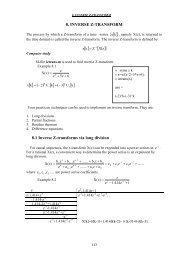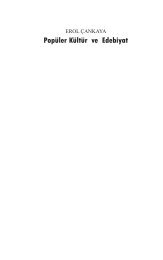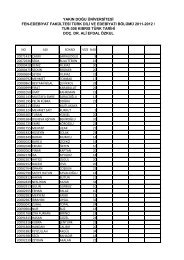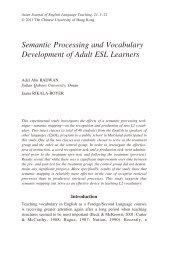(2010). The analysis of classroom talk: Methods and methodologies ...
(2010). The analysis of classroom talk: Methods and methodologies ...
(2010). The analysis of classroom talk: Methods and methodologies ...
Create successful ePaper yourself
Turn your PDF publications into a flip-book with our unique Google optimized e-Paper software.
10 Neil Mercer'What do I need to do to answer my research questions?' an open-minded researchermay avoid simplistic choices. From this stance, the most effective forms <strong>of</strong> enquiry mayinvolve the complementary use <strong>of</strong> more than one type <strong>of</strong> method, so that weaknessesare counterbalanced <strong>and</strong> evidence <strong>of</strong> more than one kind is generated. An increasingnumber <strong>of</strong> researchers seem to share this point <strong>of</strong> view.It is worth noting that more researchers also seem to be involving teachers asco-researchers in the <strong>analysis</strong> <strong>of</strong> <strong>classroom</strong> <strong>talk</strong> <strong>and</strong> interaction, usually with the aim <strong>of</strong>helping teachers gain new insights Into their everyday experiences <strong>and</strong> practice (see, forexample, Armstrong & Curran, 2006; Hennessy & Deaney, 2009). More <strong>classroom</strong>researchers also use specially designed s<strong>of</strong>tware, such as AtlasTI, NVivo, <strong>and</strong>ObserverXT to organize <strong>and</strong> annotate their digitally recorded data. (Though as onesometimes has to remind students, any such s<strong>of</strong>tware is just an organizational tool;it does not come with an in-built methodology <strong>and</strong> does not do the <strong>analysis</strong> for you!)But beyond these contemporary developments, how might this field <strong>of</strong> study mostusefully develop, in methodological terms? Some might say that researchers shouldnot just focus on <strong>talk</strong> itself, but instead make 'multimodal' analyses which treat <strong>talk</strong> asone <strong>of</strong> several communicative modes (along with gaze, gesture, written texts, pictures,video, <strong>and</strong> so on) as only in that way can the richness <strong>of</strong> <strong>classroom</strong> interaction beproperly appreciated (see, for example, Jewitt, Kress, Ogborn, & Tsartsarelis, 2004).I have engaged in some multimodal <strong>analysis</strong> myself, when studying how teachers useinteractive whiteboards, <strong>and</strong> have some sympathy with that argument (Gillen, KleineStaarman, Littleton, Mercer, & Twiner, 2007). But language remains for me theprime cultural tool <strong>of</strong> the <strong>classroom</strong>. Spoken language enables, in unique ways, thedevelopment <strong>of</strong> relationships amongst teachers <strong>and</strong> learners <strong>and</strong> the development <strong>of</strong>children's reasoning <strong>and</strong> underst<strong>and</strong>ing; so I would not subscribe to an analyticapproach which diluted its significance to that <strong>of</strong> just one <strong>of</strong> several modes.I believe the toughest methodological challenge we face is to properly recognize that<strong>talk</strong> functions in a temporal context (as explained in more detail in Mercer, 2008).Classroom education is normally a continuing, cumulative experience for theparticipants, an experience which even researchers involved in longitudinalobservational studies can only sample, only partly share. Participants draw on theirshared history all the time when they communicate. Moreover, as a leading pioneer <strong>of</strong>research into <strong>classroom</strong> <strong>talk</strong> reminded us recently, 'Most learning does not happensuddenly' (Barnes, 2008, p. 4). If we want to underst<strong>and</strong> how it happens through <strong>talk</strong> in<strong>classroom</strong>s, •we need to operate on a suitable timescale - <strong>and</strong> <strong>of</strong> course use appropriatemethods for collecting <strong>and</strong> analysing data. Approaches which rely only on briefencounters with <strong>classroom</strong> life, or on the atemporal coding <strong>of</strong> utterance types <strong>and</strong>content references, can never do justice to what teachers <strong>and</strong> learners achieve, or fail toachieve, every working day.Regarding what we might most usefully use available methods to do, a pressing needis to provide more strong empirical evidence <strong>of</strong> how involvement in <strong>talk</strong> affectseducational outcomes. <strong>The</strong>re is evidence - some <strong>of</strong> which has been available for a while- that teachers' use <strong>of</strong> certain interactional strategies with students has beneficial effectson their curriculum learning <strong>and</strong> skills in comprehending texts (Brown & Palincsar,1989; Chinn, Anderson, & Waggoner, 2001; Kyriacou & Issitt, 2008; Rojas-Drummond,Mercer, & Dabrowski, 2001; Wolf, Crosson, & Resnick, 2006). It has also been shownthat certain features <strong>of</strong> discussion amongst students are associated with thedevelopment <strong>of</strong> their individual reasoning <strong>and</strong> underst<strong>and</strong>ing <strong>of</strong> curriculum topics(Howe et al., 2005; Mercer & Littleton, 2007). We also know that the ways teachers use


